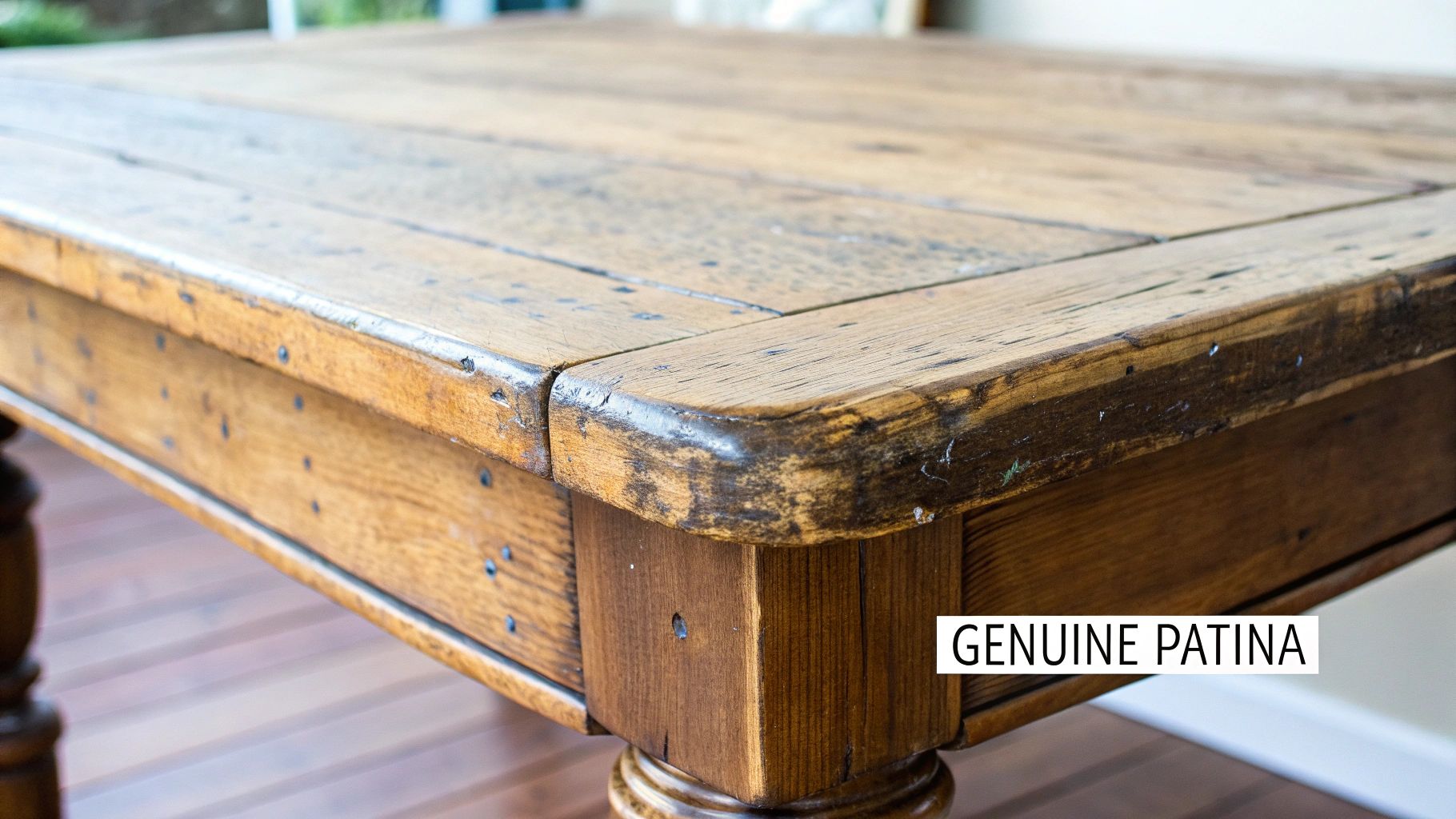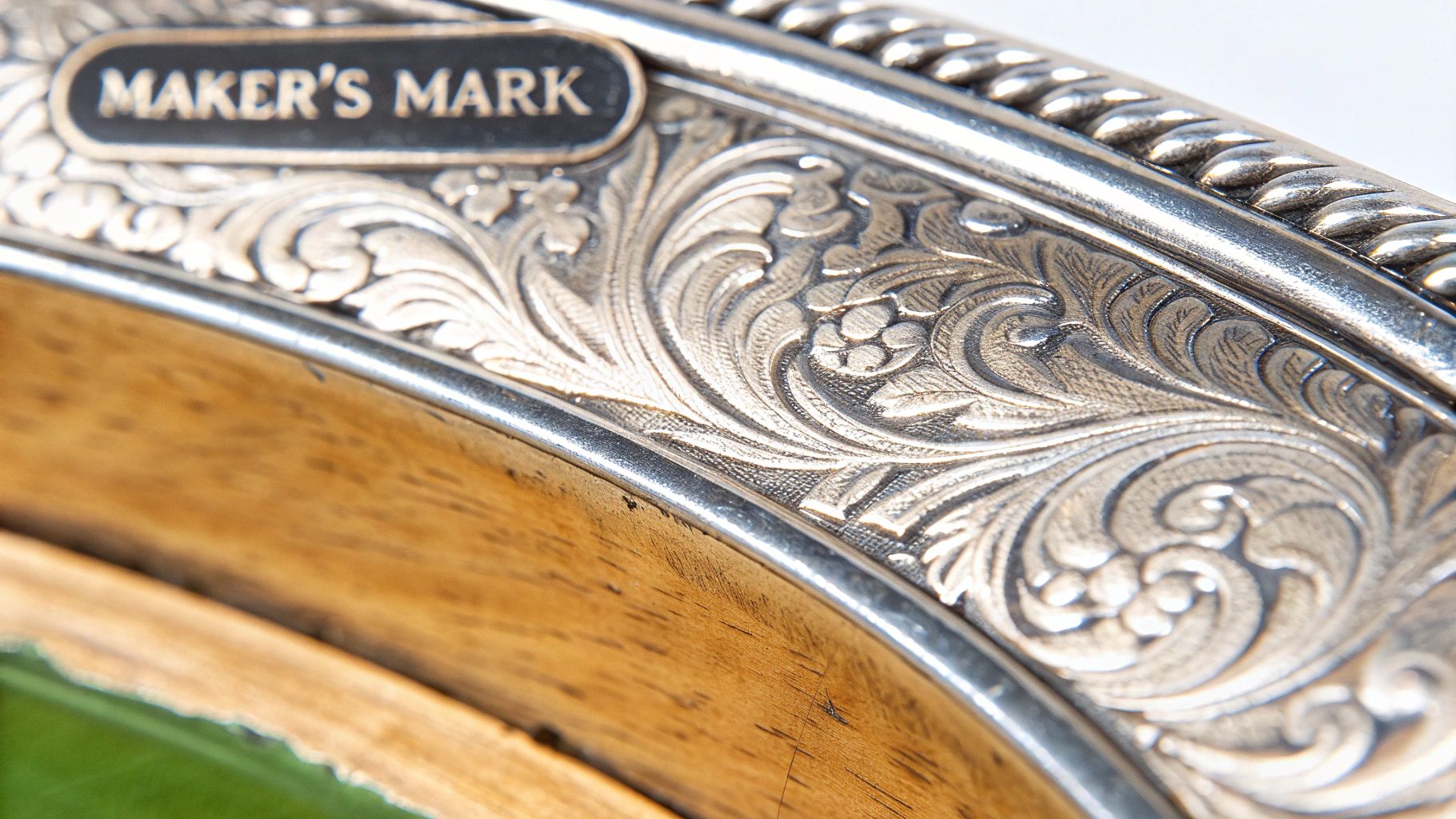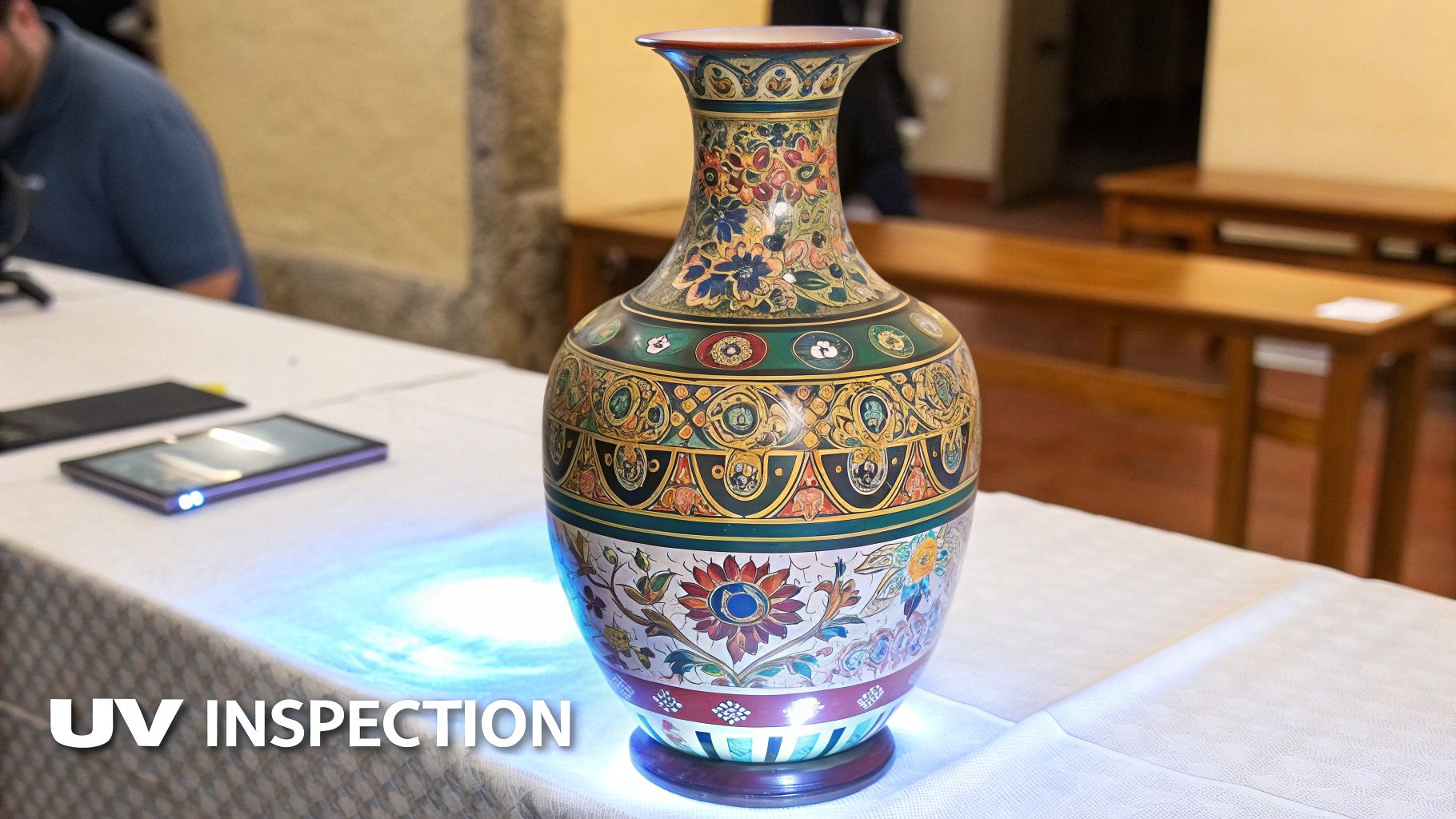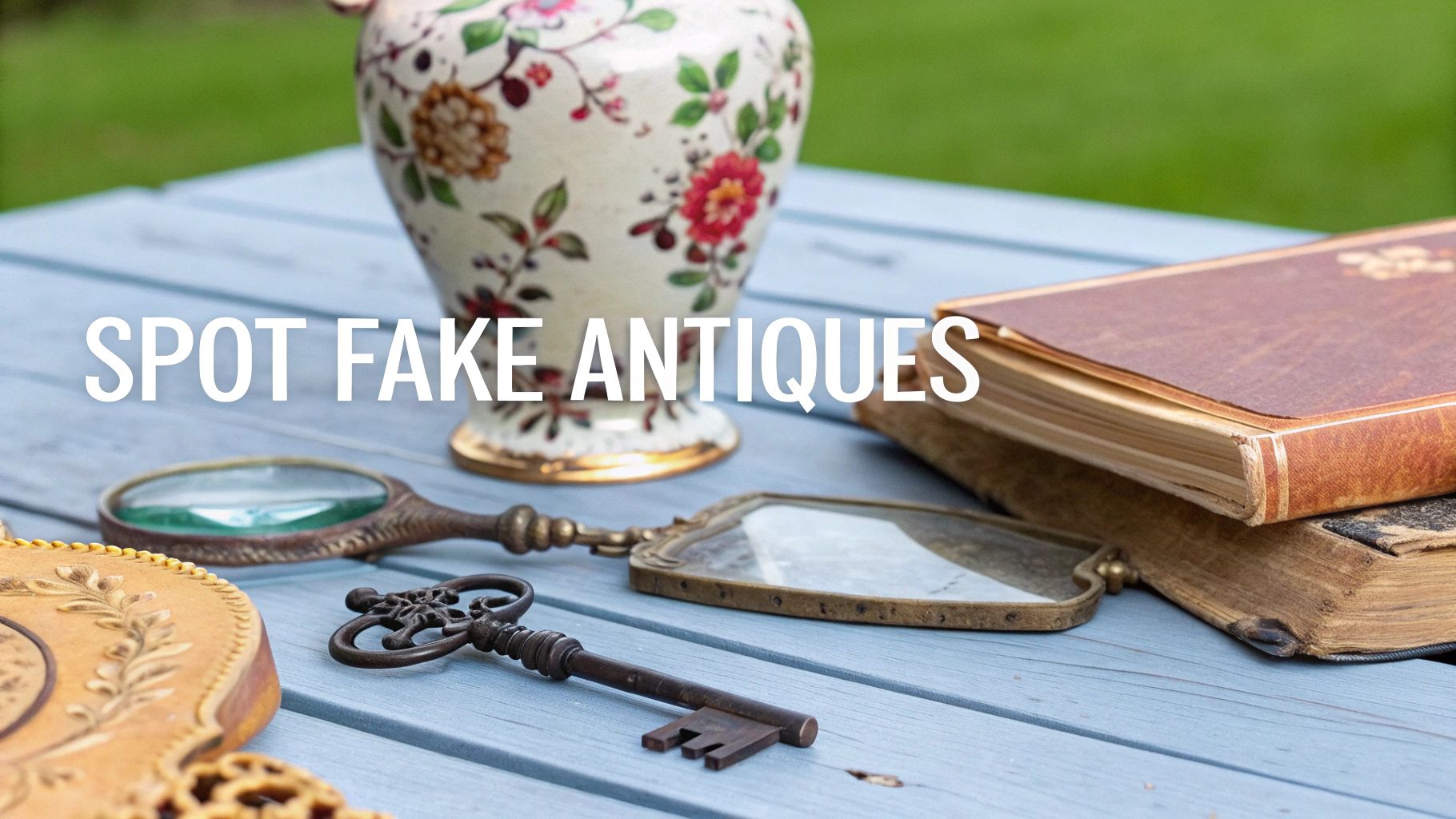There's nothing quite like the thrill of finding a unique antique, but that excitement can quickly turn to dread. What if that piece you poured your heart—and money—into is just a clever fake? The real secret to telling a genuine treasure from a modern knockoff isn't some magical sixth sense; it's a careful, hands-on process that combines a close look at the object itself with some good old-fashioned detective work. This guide will walk you through the very same techniques the pros use, so you can protect your investment and build your collection with confidence.
The Hidden World of Sophisticated Fakes

Let's be honest: navigating the antiques market today can feel like walking through a minefield. The romantic idea of stumbling upon a priceless heirloom in a dusty corner shop is often overshadowed by the harsh reality of incredibly convincing forgeries. Counterfeiters have gotten smarter. They aren't just making objects anymore; they're crafting entire stories, complete with fake documents and believable histories to fool even seasoned buyers.
This isn't just a small-time problem, either. The scale is massive, touching everything from high-end furniture and fine art to historical artifacts. It's a growing issue that's well-documented.
A recent report from Entrupy's 2024 analysis looked at over $1.4 billion worth of authenticated items. Their findings? A staggering 9% were flagged as counterfeit, a significant jump from the previous year.
This statistic really drives home a crucial lesson for every collector: healthy skepticism is your most valuable tool. Never rely on just one thing, whether it's a slick "certificate of authenticity" or a seller's charming story. It's simply too risky.
Developing a Collector's Eye
So, how do you defend yourself against this level of deception? It all starts with training your eye to see the tiny details that most people overlook. You need to become fluent in the language of the object itself while also digging into its past.
True authentication is a balancing act between two key skills:
- Hands-On Material and Craftsmanship Analysis: This is where you get up close and personal. You're examining the physical tells—the specific type of wood used, the cut of a dovetail joint, the natural aging on metal, or the particular marks on the bottom of a piece of porcelain.
- Deep Dive into Provenance and Documentation: This means tracing the item's chain of ownership. You'll be hunting for old receipts, auction catalogs, family records, and any other paper trail that can verify the story matches the physical evidence.
To help you get started, here's a quick reference table that breaks down some of the fundamental differences you'll want to look for right away.
Key Indicators of Genuine vs Fake Antiques
| Characteristic | What to Expect in Genuine Antiques | Red Flags for Fakes |
|---|---|---|
| Wear and Tear | Natural, uneven wear in logical places (e.g., drawer pulls, chair arms). | Uniform, artificial distressing; wear in spots that don't make sense. |
| Materials | Materials appropriate for the period (e.g., old-growth wood, specific alloys). | Modern materials like plywood, particleboard, or stainless steel hardware. |
| Craftsmanship | Hand-cut joinery, slight imperfections, tool marks from older tools. | Perfectly uniform, machine-cut joints; modern screws or fasteners. |
| Smell | Faint, organic smell of old wood, wax, or dust. No strong chemical odors. | Strong smell of new stain, varnish, glue, or a musty smell from forced aging. |
| Weight | Often heavier than modern counterparts due to solid wood and denser materials. | Surprisingly light, indicating cheaper, newer, or composite materials. |
Think of this table as your initial checklist. If an item starts raising red flags here, it’s a clear signal to proceed with extreme caution.
This guide will break down these methods into practical, actionable steps. We'll show you how to combine that crucial physical inspection, diligent research, and even modern tools like the Curio app to build a collection you can truly trust. By learning to read these subtle clues, you'll be well on your way to spotting the real treasures and steering clear of costly fakes.
Reading the Clues in Materials and Craftsmanship

The real story of an antique isn't in the seller's pitch—it's written in the very grain of the wood, the feel of the metal, and the delicate glaze of the ceramic. To spot a fake, you need to get hands-on and train your senses to pick up on the subtle clues that separate a century of honest use from a few days of clever forgery.
A genuine patina, for instance, is earned. It's the unique finish that comes from decades of sunlight, air, and human touch. This creates a logical, if uneven, pattern of wear. Look for darker areas where oils from hands would have settled, like around drawer pulls or on the arms of a chair. Then, notice the lighter, sun-bleached spots.
A classic forger's trick is to slather on chemicals to create a dark, uniform "aged" look. If a piece is the exact same shade from top to bottom, even in recessed corners that hands and light would never reach, your alarm bells should be ringing. Real age is never perfectly even.
Inspecting Wood and Construction
The way something was built often tells you more than anything else. Before the 19th century, wood was typically cut by hand or with pit saws, which left straight, slightly irregular saw marks. If you spot perfectly circular saw marks on a piece advertised as "18th-century," you're looking at a dead giveaway of modern machinery.
Dovetail joints—those interlocking connections you see in drawers—are another huge tell. Their style can practically date a piece for you.
- Early Period (Pre-1800s): The joints are usually large, a bit irregular, and you can often see the scribe lines where the craftsman marked them by hand.
- Machine-Cut (Post-1860s): These are perfectly uniform, with crisp, sharp corners and an almost robotic precision.
Wood also shrinks over time, but it only shrinks across the grain, not with it. This is why antique round tables are often slightly oval-shaped today. If you measure a round tabletop and find it’s a perfect circle, the top was likely replaced, or the whole piece is a modern reproduction. For a deeper look into this, learning how to identify antique furniture and its construction is invaluable.
Analyzing Other Common Materials
These same principles apply just as much to ceramics, metalware, and textiles. Every material ages in its own way and has its own signs of authenticity.
With porcelain, try holding it up to a light. High-quality antique porcelain often has a beautiful translucency that cheaper, modern earthenware just doesn't have. Always check the bottom for a maker's mark. Hand-painted marks from before 1800 tend to be less precise than the neat stamped or printed marks of later periods. Also, if you see the name of a country, that often dates the piece to after 1891, when a U.S. law required it for imported goods.
When you're looking at silver, hunt for the hallmarks. These tiny stamps identify the maker, the silver purity, and the city where it was assayed. These marks are incredibly well-documented, so you can easily cross-reference them in a guidebook. Forgers often get these details wrong, using incorrect symbols or placing them sloppily. By learning to read these physical clues, you can build the confidence to spot a fake from a mile away.
Investigating an Antique's Life Story
An antique without a story is just an old object. What truly breathes life into it is its provenance—the documented history of its ownership. This is where you'll find a huge part of its value and, most importantly, its authenticity. Learning how to spot fakes means you have to put on your detective hat and trace an item's journey through time. It's a fascinating process, but you need to be sharp. Remember, a skilled forger is just as good at faking a history as they are at faking the item itself.
Start With the Paper Trail
Your first stop should always be the paper trail. Look closely at any documents that come with the piece—receipts, old letters, previous appraisal reports, anything. Do they look and feel right for their age? Paper from 1880, for instance, shouldn't be crisp and bright white. The ink, the handwriting, the letterhead—it all needs to match the period.
Be very skeptical of vague or overly grand claims. If a seller tells you an item belonged to a "notable European family" but can't provide any names, dates, or verifiable details, that's a classic red flag. Real provenance is specific.
Digging Deeper on Your Own
Don't just take the seller's word for it; your own research is essential. Thankfully, digital archives have made this easier than ever. Start digging through old auction catalogs, museum databases, and historical society records. You might be surprised by what you find.
For example, if you're looking at a piece of jewelry, its construction, materials, and markings can point to a specific era or maker. You can then cross-reference those details with historical records. This is a whole field of its own, and you can learn more about this by exploring how to identify antique jewelry and its unique tells.
This diligent research helps you build a case for authenticity, piece by piece. Does the story the seller told you line up with what the object itself is telling you? If they claim a chair belonged to a French aristocrat but the joinery is clearly English, something is very wrong.
Provenance is more than just a story; it's a chain of evidence. Every single link in that chain must be verifiable. A single broken or missing link should make you question the entire history.
The Modern Challenge of Verification
Verifying an item's history has never been more challenging. Fakes are everywhere, and consumer attitudes don't always help. A startling survey by the European Union Intellectual Property Office found that over 50% of young consumers admitted to knowingly buying counterfeit products online. When fakes become this common, it puts even more pressure on serious collectors to find reliable ways to verify authenticity. You can discover more insights about consumer counterfeit trends to understand the scale of the problem.
This is where new technology is starting to make a real difference. Secure digital ledgers, like those built on blockchain, are creating unchangeable, transparent records of ownership that are nearly impossible to forge. As this tech becomes more widespread, it will add a powerful layer of security for collectors.
By combining old-school detective work with these modern tools, you can confidently piece together and validate an antique's true life story.
Using Modern Tech to Unmask Fakes

While training your eye and digging into an item’s past are timeless skills, let’s be honest—our senses can only take us so far. It’s a tough game. Luckily, technology has given us a powerful new layer of defense in the fight against fakes. Today’s collectors have access to tools that can analyze an item with a precision that’s simply beyond human ability.
This is where artificial intelligence has really stepped up. AI-powered services are becoming absolute game-changers, especially for high-end branded goods, and we're seeing their influence spread into the broader world of antiques. These platforms use microscopic imaging and enormous databases to sniff out forgeries with incredible accuracy.
Think of it this way: an AI can see the texture of leather down to the individual pore or spot a tiny flaw in a logo that’s completely invisible to you and me. It sounds like something out of a sci-fi movie, but it’s a real tool that authenticators are using right now.
The Power of Microscopic Analysis
Services like Entrupy are putting professional-grade tools right into the hands of collectors and resellers. They provide a small device that takes microscopic photographs of an object, capturing details you'd never see on your own—the specific weave of a canvas, the grain in a wood veneer, or the brushstrokes on a piece of ceramic.
The AI then gets to work, comparing these microscopic "fingerprints" to a massive, ever-growing database of millions of images from both genuine and known counterfeit items.
The result? An objective, data-driven verdict on authenticity, often with an accuracy rate of over 99%. This tech all but removes human error and guesswork from the initial authentication process.
This is so effective because even the most skilled forgers can’t quite replicate materials and construction at a microscopic level. They might nail the overall appearance, but the AI catches the tiny details they inevitably miss. For instance, it can easily tell the difference between a hand-stitched pattern and a machine-made one or spot tiny inconsistencies in metal plating that scream "fake."
Big Data Policing Online Marketplaces
Technology isn't just for inspecting individual items; it’s also cleaning up the very places we shop. Major online marketplaces are now deploying smart data analytics to flag and remove fraudulent listings before anyone gets duped.
And it’s a huge effort. The e-commerce giant Alibaba, for example, uses hundreds of real-time data models to scan listings for red flags. These algorithms look at everything—the seller's history, the item's price, even the specific words used in the description. By connecting these dots, the system finds patterns that strongly point to counterfeit goods. This proactive policing has resulted in the seizure of goods valued at over $200 million. To learn more, you can see how data analytics fights counterfeiting on a massive scale.
These tools, from AI-powered microscopic analysis to big data surveillance, offer a vital safety net. They give you the power to verify an item's authenticity with a level of certainty that just wasn't possible before, making it much harder for fakes to find their way into your collection. When you combine these modern solutions with traditional, hands-on inspection, you have the ultimate advantage.
When to Call in a Professional Appraiser

While the methods we've covered can turn you into a savvy detector of fakes, there are moments when a magnifying glass and your own research just won't cut it. Part of becoming a skilled collector is knowing your limits and recognizing when it's time to bring in an expert for a definitive opinion.
This becomes absolutely critical when you're dealing with a potentially high-value piece. If you suspect an item could be worth thousands, or even tens of thousands, the cost of a formal appraisal is a tiny fraction of its potential value. Think of it as insurance—a small investment that can save you from a huge financial blunder.
The other clear signal is when you’ve simply hit a wall. Maybe you’ve spent days trying to decipher a cryptic maker's mark or untangle conflicting provenance documents. When your research just sends you in circles, a professional can slice through the confusion with their specialized, hard-won experience.
Finding a Credible Expert
Finding a trustworthy appraiser is just as important as the appraisal itself. The antique world has its share of self-proclaimed experts, so you need to look for someone with credentials from a respected professional organization.
Start by seeking out members of groups like:
- The Appraisers Association of America (AAA)
- The American Society of Appraisers (ASA)
- The International Society of Appraisers (ISA)
These bodies enforce strict ethical codes and demand continuous education, so a membership is a solid sign of professionalism and commitment.
Once you find a candidate, don't hesitate to interview them. A true pro will be transparent about their specific field. You wouldn't ask a 19th-century furniture specialist to authenticate a piece of ancient Roman glass, after all.
Ask them directly: "What's your experience with [your specific type of item]?" and "Could you provide references from a few past clients?" Their willingness and the quality of their answers will tell you everything you need to know.
Understanding the Different Types of Appraisals
It's also important to know that "appraisal" isn't a one-size-fits-all term. You need to be clear about your goal, as it shapes the entire process. The two most common types you'll encounter are for insurance purposes and for authentication.
An insurance appraisal determines the retail replacement value. This is the estimated cost to purchase a similar item from a high-end gallery or dealer today. This figure is almost always higher than what you might get if you were to sell it.
An authentication appraisal, on the other hand, is laser-focused on one question: is this piece genuine? While valuation is often part of the report, the primary goal is simply to verify its age and origin. To dig deeper into this, you can check out our detailed guide on how to value antiques.
Hiring a professional isn't admitting defeat; it’s a smart, strategic move made by seasoned collectors. It provides that final, authoritative word on an item's legitimacy, giving you complete peace of mind and protecting the integrity—and value—of your collection.
FAQ on Spotting Fakes
As you get deeper into the world of antiques, you'll find that knowing the basics is one thing, but dealing with the tricky situations you encounter in the wild is another. Here are some of the most common questions I hear from fellow collectors, with straightforward answers to help you navigate the gray areas.
Is an Antique with Repairs Less Valuable?
That's a fantastic question, and the answer really is "it depends." A skillful, period-appropriate repair can actually be a good thing. Think about it: a well-done, almost invisible fix on the leg of a 200-year-old chair keeps it standing and preserves its history. It's often much better than letting the piece collapse.
Where you run into trouble is with clumsy or deceptive repairs. If you see modern materials like shiny new screws or plastic wood filler on a 17th-century chest, that’s a huge red flag that will tank the value. The problem isn't the repair itself, but rather a bad repair that either looks awful or tries to hide a fatal flaw.
Can I Trust a Certificate of Authenticity?
My advice? Always view a Certificate of Authenticity (COA) with a healthy dose of skepticism. A certificate is only as good as the person or institution that signed it. Sadly, forgers are just as skilled at faking paperwork as they are at faking antiques. They can produce some very official-looking documents.
Before you even think about accepting a COA, you have to do your homework on the issuer. Are they a well-known, respected expert in that specific type of antique? A vague certificate from "The Antique Society" or some unknown "guild" is basically meaningless.
What Is the Single Biggest Mistake New Collectors Make?
Hands down, the most common pitfall I see is falling for a great story instead of falling for a great object. Fakers are incredible storytellers. They will weave a fantastic tale about where an item has been and who owned it, hoping you get so lost in the romance that you ignore the obvious physical flaws.
Always let the object speak for itself. Look at the wood, the joinery, the patina, and the wear before you listen to the story. If the physical evidence doesn't line up with the tall tale, trust the evidence. Every single time.
How Reliable Are Online Authentication Services?
This is a great, modern question. Technology is definitely changing the game. Established online services that use microscopic imaging and AI have shown impressive accuracy rates, especially for things like designer handbags. A platform like Entrupy, for example, has built a solid reputation. These tools are now expanding into the broader world of art and antiques, which is exciting.
However, their usefulness really hinges on the specific item and how much data they have to compare it against. They're a fantastic resource for an unbiased, data-backed opinion. But for now, they work best as part of your overall strategy. Combine them with your own hands-on research and, for anything truly valuable, the eye of a human appraiser. They add a powerful layer of confidence but don't replace old-fashioned due diligence.
Now that we’ve covered some frequent questions, let's put them into a quick reference table. This can be a handy resource when you're out in the field and need a fast answer.
| FAQ on Spotting Fakes | |
|---|---|
| Question | Expert Takeaway |
| Is a repaired antique less valuable? | Not always. A professional, period-correct repair can preserve value. A modern or deceptive repair will significantly decrease it. |
| Should I trust a Certificate of Authenticity? | Be skeptical. Verify the issuer's credentials independently. A COA is only as credible as the expert who signed it. |
| What's the biggest mistake for beginners? | Believing a great story over the physical evidence. Let the object tell its own story first through its materials and craftsmanship. |
| Are online authentication services reliable? | They can be highly accurate for specific categories. Use them as a powerful tool alongside your own research and expert consultation, not as a replacement. |
This table serves as a good summary, but remember that every antique is unique. Always stay curious and keep learning—it's your best defense against fakes.
Ready to turn your own finds into fascinating stories? Curio makes it easy. Just snap a photo of any antique or vintage item, and let our AI-powered app reveal its history, origin, and estimated value in seconds. Stop guessing and start knowing. Download Curio and bring your collection to life at https://www.curio.app.
